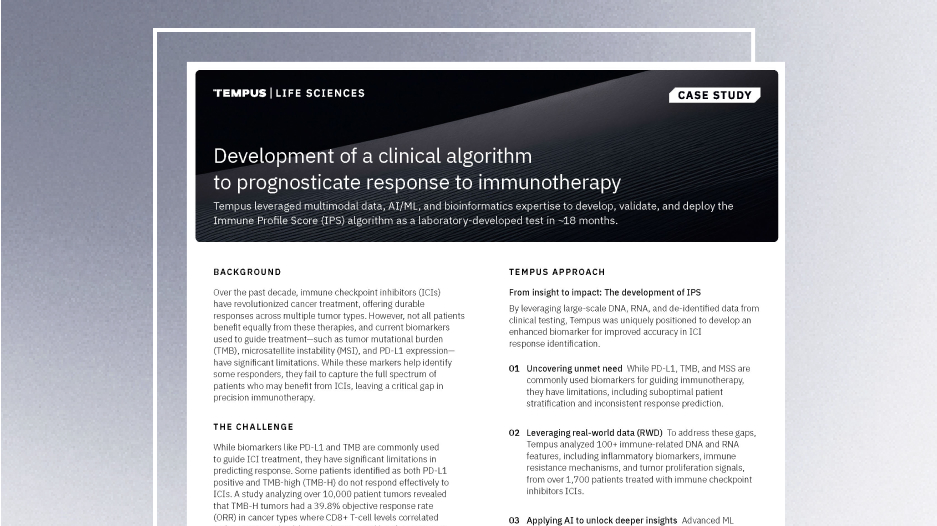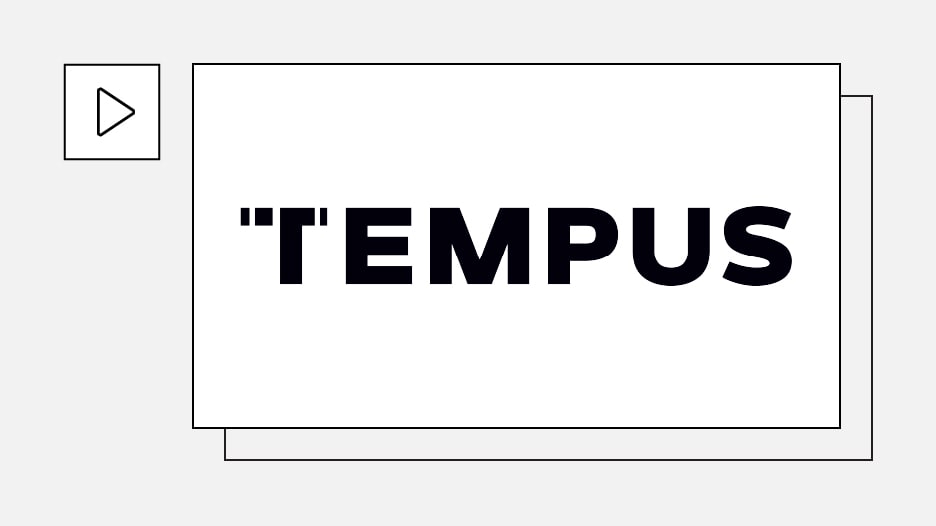-
PROVIDERS
Register now
Are you getting the full picture? A webinar series on the power of comprehensive intelligent diagnostics
-
LIFE SCIENCES
Enroll now
Tempus’ Patient-Derived Organoid ScreensEvaluate the efficacy of your preclinical compounds using fixed organoid panels designed for diverse therapeutic applications. Space is limited — enroll by June 30, 2025, to secure your spot.
-
PATIENTS
It's About Time
View the Tempus vision.
- RESOURCES
-
ABOUT US
View Job Postings
We’re looking for people who can change the world.
- INVESTORS
04/04/2025
Q&A: How cutting-edge technologies are helping to advance precision medicine
In a recent webinar, Tempus leaders showcased how AI and ML-enabled technologies are revolutionizing the healthcare field and transforming precision, offering a glimpse into the future of healthcare innovation.
Speakers
Jonathan Ozeran
VP, Generative AI & Head of Tempus One, Tempus

Chris Scotto DiVetta
SVP & General Manager of AI Applications, Tempus

VP, Generative AI & Head of Tempus One, Tempus

Chris Scotto DiVetta
SVP & General Manager of AI Applications, Tempus

To explore these technological advancements, Tempus’ Jonathan Ozeran, Vice President of Generative AI & Head of Tempus One, and Chris Scotto DiVetta, Senior Vice President & General Manager of AI Applications, unveiled the latest AI and ML applications within the Tempus platform.
What applications has Tempus developed to support advanced, personalized care? |
Chris Scotto DiVetta: At Tempus, we’ve developed a suite of applications designed to bring actionable insights to the forefront of healthcare. For researchers, we offer Tempus Lens, a powerful tool that allows exploration of our vast database of 8 million de-identified patient records. Lens is instrumental in identifying patterns among both treatment responder and non-responder populations, uncovering potential new targets and informing clinical trial designs.Tempus One, our generative AI assistant, is integrated across all these platforms and is continuously evolving with new capabilities. It’s not just an assistant; it’s the cornerstone of our software suite, enhancing every tool we’ve developed. |
What AI features are available for researchers? |
Jonathan Ozeran: Tempus Lens is our cloud-based data analytics platform, harnessing the power of multimodal data to assist our life sciences partners and researchers. The goal of Lens is to simplify the process of stratifying patient cohorts, making it as straightforward and swift as possible. The platform boasts a suite of basic and advanced filters, designed to streamline the search process across Tempus’ extensive dataset of over 8 million de-identified patient records.One standout generative AI feature of Lens is its cohort-building functionality, which is currently in Beta. When exploring complex queries, for example, identifying patients with triple-negative breast cancer treated with specific drugs and carrying certain genetic mutations, Lens employs gen AI agents to dissect the query and apply the appropriate filters. This system helps to distinguish between different assays and mutations, ensuring that only clinically significant results are considered. What was once a time-consuming task now returns results in mere seconds. This rapid turnaround is transformative for researchers who can move from hypothesis to sizing a cohort of interest almost instantaneously.Upon applying the filters, Lens doesn’t just stop at providing a number; it offers a visualization interface with detailed information, including demographics and genetic variants. For a deeper dive, it can display additional analyses like disease response derived from structured and abstracted clinical data from patient records. Lens has lowered the barrier to entry for using real-world data. Previously, navigating analytical tools might have required extensive training and familiarity with medical nomenclature. Now, thanks to the natural language capabilities of Lens’ cohort-building tool, it’s as easy as conversing in your own terminology.While structured and molecular data are readily available, Lens also acknowledges the challenge of unstructured clinical notes. These documents often contain valuable insights, such as adverse events, symptoms, or specific details from imaging tests, which are not always captured in structured EMR data. Lens is evolving to incorporate these elements, making it an even more comprehensive tool for research and analysis. |
|
“Lens has lowered the barrier to entry for using real-world data. Previously, navigating analytical tools might have required extensive training and familiarity with medical nomenclature. Now, thanks to the natural language capabilities of Lens’ cohort building tool, it’s as easy as conversing in your own terminology.” – Jonathan Ozeran, Vice President of Generative AI, Tempus |
How will Lens support the interrogation of unstructured data elements? |
| Jonathan Ozeran: Tempus One will also support deeper cohort exploration, enabling researchers to ask and answer complex questions about patient data. For example, researchers can inquire about the prevalence of specific genetic mutations like PIK3CA or RB1 within a patient cohort, and quickly receive a snapshot of the data.It’s designed to handle intricate queries, allowing researchers to probe further into the data. For instance, if we want to know the percentage of patients with a particular mutation across all notes and records, Patient Explorer can analyze the entire cohort and return results in seconds. |
What approach does Tempus take to developing new AI capabilities for its products? |
Jonathan Ozeran: We’ve developed an in-house version of Tempus One using an agentic workflow platform that we call “Agent Builder.” This proprietary, custom-built toolkit enables our team to construct additional agents that address the needs of our clients. One example is our Publications Agent, which sifts through our extensive collection of publications to quickly retrieve information such as authors, conference details, and publication dates. This process is streamlined through what we call ‘assemblies’ within the Agent Builder. The ‘assemblies’ manage the inputs, orchestration tasks, and outputs, culminating in a conversational interface that is both user-friendly and versatile.Behind the scenes, Agent Builder allows us to have full programmatic control over how these agents function. We can specify the source of the documents, choose the model, and define the output. This level of customization is crucial as it informs how we architect applications and bring them to market.Even more innovation occurs in the workflow within Agent Builder. Here, we assemble the building blocks of an agent, allowing us to craft queries and receive responses. For example, we can create an agent to query PubMed with a focus on ADCs in oncology, and the agent will think through the process, using the collective intelligence of all the agents we’ve built at Tempus. This technology isn’t just for show; it’s a practical tool that empowers our team members to ask questions and get answers quickly. Whether it’s summarizing research or creating an agent from scratch, Agent Builder provides a functional tool that can be used in seconds, demonstrating the agility and power of AI in advancing our work at Tempus. |
To experience the full depth of our AI demonstrations and gain comprehensive insights into Tempus’ role in advancing precision medicine, we invite you to watch the webinar recording. Connect with our team to request a full demo of Tempus’ innovative tech solutions here.
*Note: content edited for clarity.
Please note that the content in this document has been revised for clarity and conciseness. Some language and formatting may have been adjusted to enhance readability while preserving the original meaning and intent of the discussion.
-
04/02/2025
Development of a clinical algorithm to prognosticate response to immunotherapy
Discover how Tempus developed and deployed the Immune Profile Score (IPS)—a powerful algorithm that provides prognostic insights into patient outcomes following treatment with immune checkpoint inhibitors (ICIs)—in ~18 months. This case study highlights the AI-driven methodology, real-world validation, and the impact of IPS in precision oncology.
Read more -
03/25/2025
AI & ML in action: Unlocking RWD with GenAI through Tempus Lens
Discover how Tempus is equipping researchers with innovative AI solutions to fully leverage the potential of multimodal data. Gain insights from a panel of leaders across healthcare and life sciences as they discuss the impact of these advanced tools on delivering insights with speed.
Watch replay
Secure your recording now. -
03/11/2025
Case Report: Pharmacogenomic testing and mood stabilizers
This real-world case demonstrates how the Tempus nP pharmacogenomic test facilitated a personalized treatment approach for a patient with bipolar disorder.
Read more


